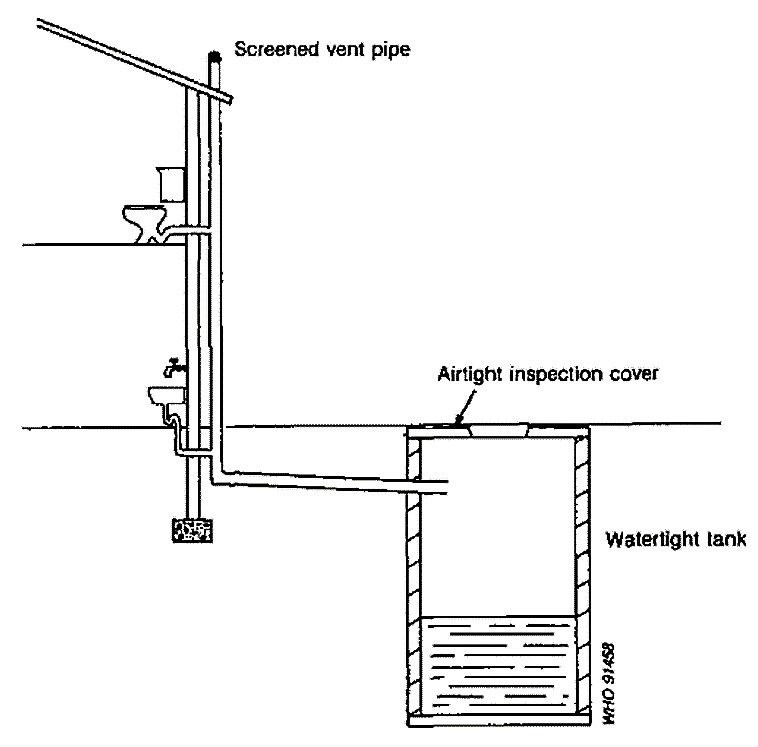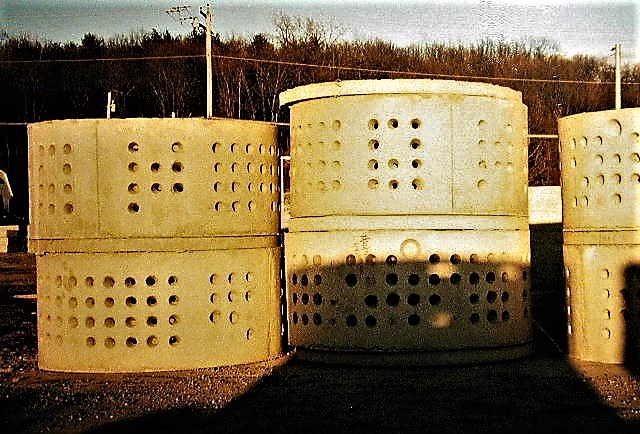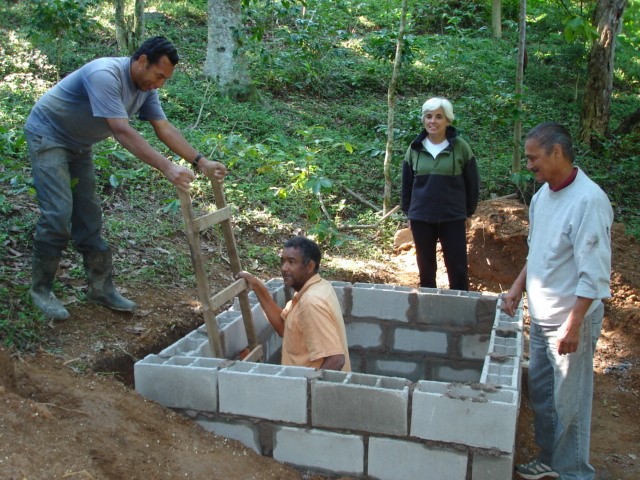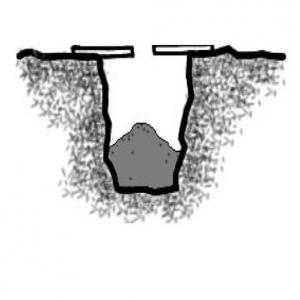Executive Summary
A cesspit, or cesspool is a tank pit used for the temporary collection and storage of sewage or waste. The pit is sometimes lined with bricks or concrete and mostly covered with a slab. In case the pit is constructed water-tight, it needs to be emptied frequently. When the pit is not tight, liquids leached out if soil conditions allow, while solids decay and collect in the base. The treatment effect of a cesspit is very low. Emptying can result in high operation and maintenance costs. Cesspits which allow soil infiltration require less frequent emptying but groundwater pollution can occur. There are many better solutions in the sanitation sector than a cesspit.
| In | Out |
|---|---|
Blackwater, Faecal Sludge, Brownwater, Urine or Yellowwater, Faeces |
Blackwater, Faecal Sludge |
Introduction
Cesspit (also known as cesspool)is a very general description for different on-site collection systems for liquid wastes, mostly blackwater or faeces. If a cesspit is sealed, it is also known as underground holding tank and can be used as a transfer station. Furthermore it is possible to set a cesspit below or beside a toilet. In this case it is very similar to a single pit. This system is still better than no sanitation from a point of view of the health risk for the user, but the treatment process in the cesspit is very limited. A secondary treatment of the collected sludge is necessary (see paragraph “Operation and Maintenance”). Therefore it is advantageous to use a more efficient system for treating human excreta (e.g. dry and semi-dry systems such as UDDT, composting toilets, or a water-based toilet system which is connected to a twin-pit for pour flush toilets, septic tanks ora semi-centralised secondary treatment system such as constructed wetlands (free surface, horizontal flow or vertical flow or non-planted filters.
Treatment Process and Basic Design Principles
Cesspits are simple pits collecting excreta, faeces and urine. They are well one of the most common on-site wastewater collection system in the absence of a sewered collection network. They typically serve one household or are shared by families, or neighbours of the same multiple apartment building. The size of the tank depends on the availability of land and on the construction costs. Their capacity might range from 5 to 50 m3. The periods between each complete evacuation of the contents of cesspits vary between a couple of months up to two years (WERNER et al. 2000; WHO 1992).

The cesspit is lined with bricks, concrete or plastic. Cess-pits are either water-tight (such as underground holding tanks, see also transfer stations or permeable (similar to soak pits). Treatment processes in permeable cesspits include wastewater settling (greywater and blackwater), anaerobic sludge digestion and percolation of liquid into the subsurface where microbial action degrades part of the organic fraction (MOREL & DIENER 2006; WERNER et al. 2000). As the effluent leaches from the permeable cesspit and migrates through the unsaturated soil matrix, faecal organisms are removed (similar as in soak pits). The degree of faecal organism removal varies with soil type, distance travelled, moisture and other environmental factors and thus, it is difficult to estimate the necessary distance between a pit and a water source (TILLEY et al. 2008).
If the groundwater table is high or the soil is very permeable, a cesspit can allow raw sewage to directly enter groundwater with minimal biological cleansing, which leads to groundwater contamination and undrinkable water supplies. Thus, in the case of high groundwater table, the cesspit should be constructed watertight. The disadvantage of a watertight cesspit is that it is filled up much faster. There are several pre-fabricated types made out of synthetic material (e.g. fibreglass) or concrete.

Costs Considerations
Cesspit is one of the simplest and cheapest methods to collect faeces. But still, the economic costs for a household that needs its cesspit emptied are high. That is why often cesspits are constructed for infiltration of the leachate into the soil, which leads to less frequent emptying and thus less costs. Comparing the costs for emptying by vacuum truck with an average income of people found in rural communities in developing countries, the cost for emptying cesspits are even more expensive (WERNER et al. 2000).
In some cases, untreated greywater is used to irrigate trees in backyards in order to minimise regular desludging of the cesspits in the household (MOREL & DIENER 2006). This could endanger the environment and the health of the locals around the irrigated area.
Operation and Maintenance
As already mentioned, a cesspit has to be emptied regularly by a vacuum truck (see also motorised emptying and transport) or manually (see human powered emptying and transport similar to a pit latrine. The faecal sludge needs to be correctly disposed and further treated (e.g. small or large composting, anaerobic digestion, or drying beds) because it contains still active pathogens. It is necessary that somebody takes care about the cesspool. The person responsible has to pay attention that that cesspit does not overflow and that it is well protected against external water infiltration (covered with a slab and the entrance of the manhole should be slightly higher than the surrounding).

Health Aspects
When there is a high groundwater table, the leachate of the cesspit that does infiltrate into the soil can contaminate the groundwater. In the West Bank for example, this is why cesspits are considered to be the main source of groundwater pollution in the Palestinian Territories (WERNER et al.2000). ROY et al. (1984) give some guidelines for minimal distances between permeable systems and drinking water sources (chapter 4 and 5). In densely populated areas with many permeable cesspits or pit latrines, the risk of a groundwater contamination remains however extremely high (WHO 1992). In any case it remains very difficult to give some guidelines without knowing the type and hydraulic conductivity of the soil.
Manual removal should be avoided, because the risk of an infection is high. A cesspit is covered with a slab all the time. This prevents the spread of pathogens, bad odour, nuisance by flies or mosquitoes and contact of humans or animals with the collected sludge (WHO 1992).
It is dangerous to lift the slab by its own to check the level. Toxic gases from the cesspit can overcome the person very quickly. Therefore, an alarm should be installed to see check the level of the sludge (e.g. a float ball) (WTE Ltd. (Editor) (n.y.).
At a Glance
| Working Principle | A household is connected to the cesspit, which collects and stores the wastewater and faecal sludge for several months. As soon as it is filled up it must be emptied by a vacuum truck. |
| Capacity/Adequacy | In densely populated areas where no sewer system exists. |
| Performance | The treatment processes of the faecal wastewater in the cesspit are limited. |
| Costs | High O&M costs due to regularly emptying. |
| Self-help Compatibility | Can be built and repaired with locally available material. |
| O&M | Has to be emptied regularly by a vacuum truck. The sludge needs secondary treatment. |
| Reliability | If well constructed and operated, the faecal sludge is at least collected in the pit and risks of infections are lower. |
| Main strength | Sludge is collected in a covered pit. |
| Main weakness | High O&M costs, can lead to groundwater pollution. |
A cesspit is a common solution to collect and store wastewater from households in densely populated areas when there is nothing else. It is an easy, but definitely not the best facility as treatment is minimal, the risk of groundwater pollution high and frequent emptying often expensive. Furthermore, there must be an appropriate facility for secondary treatment of faecal sludge from cesspools.
CESSPOOLS for onsite wastewater disposal
Project Rainforest with Sustainable Practices
Greywater Management in Low and Middle-Income Countries, Review of Different Treatment Systems for Households or Neighbourhoods
This report compiles international experience in greywater management on household and neighbourhood level in low and middle-income countries. The documented systems, which vary significantly in terms of complexity, performance and costs, range from simple systems for single-house applications (e.g. local infiltration or garden irrigation) to rather complex treatment trains for neighbourhoods (e.g. series of vertical and horizontal-flow planted soil filters).
MOREL, A. DIENER, S. (2006): Greywater Management in Low and Middle-Income Countries, Review of Different Treatment Systems for Households or Neighbourhoods. (= SANDEC Report No. 14/06 ). Duebendorf: Swiss Federal Institute of Aquatic Science (EAWAG), Department of Water and Sanitation in Developing Countries (SANDEC) URL [Accessed: 27.05.2019]Compendium of Sanitation Systems and Technologies
This compendium gives a systematic overview on different sanitation systems and technologies and describes a wide range of available low-cost sanitation technologies.
TILLEY, E., LUETHI, C., MOREL, A., ZURBRUEGG, C. and SCHERTENLEIB, R. (2008): Compendium of Sanitation Systems and Technologies. Duebendorf, Switzerland: Swiss Federal Institute of Aquatic Science and Technology (EAWAG) and Water Supply and Sanitation Collaborative Council (WSSCC) URL [Accessed: 15.02.2010] PDFEcosan closing the loop in wastewater management and sanitation
Besides basic theory, this proceeding of the international symposium of Ecosan in Bonn (Germany) includes several presentations, case studies and sustainable techniques in the sanitation section.
WERNER, C. SCHLICK, J. WITTE, G. HILDEBRANDT, A. (2000): Ecosan closing the loop in wastewater management and sanitation. Eschborn: The Deutsche Gesellschaft für Internationale Zusammenarbeit (GIZ) GmbHA Guide to the Development of On-site Sanitation
The publication presents appropriate technologies for sanitation and highlights socio-economic aspects of planning and implementing. Emphasis is given to household-level sanitation improvements for urban areas, as well as rural areas and small communities. Background information on sanitation, in-depth technical information on the design, construction, operation and maintenance and project planning and development processes involved in projects and programmes complement the book.
WHO (1992): A Guide to the Development of On-site Sanitation. Geneva: World Health Organisation (WHO) URL [Accessed: 14.04.2010]Cesspits and Cesspools
Manual on the design, construction and maintenance of low-cost pour-flush water seal latrines in India
This manual has been prepared for agencies, contractors and individuals involved in various aspects of the low-cost pour-flush water seal latrine programme in India. The inherent principles are, however, of general application; with minor modifications, the technical details can be readily adapted to meet the needs of different areas, particularly where water is used for anal cleansing. The manual presents salient features in regards to design, construction and maintenance as well as the administration of low-cost pour-flush water seal latrines with offset twin pits. It contains extensive drawings, tables of quantities for construction materials used for different designs as well as standard forms for by-laws and for general information on project administration and supervision.
ROY, A.K. CHATTERJEE, P.K. GUPTA, K.N. KHARE, S.T. RAU, B.B. SINGH, R.S. (1984): Manual on the design, construction and maintenance of low-cost pour-flush water seal latrines in India. (= TAG technical note; no. 10 ). United Nations Development Programme (UNDP) and World Bank URL [Accessed: 01.06.2010]Water Pollution Control - A Guide to the Use of Water Quality Management Principles
This document is rather old, but its publication was a milestone as it demonstrates WSSCCs capacity to bring together water and sanitation professionals from industrialised and developing countries to formulate practical guidance on a key issue of the day. Mainly regulatory, financial and technical aspects are discussed and illustrated with an extensive collection of case studies from the developing world.
HELMER, R. ; HESPANHOL, I. (1997): Water Pollution Control - A Guide to the Use of Water Quality Management Principles. World Health Organization (WHO), Water Supply and Sanitation Collaborative Council (WSSCC) and United Nations Environment Programme (UNEP) URL [Accessed: 21.04.2010]Greywater Management in Low and Middle-Income Countries, Review of Different Treatment Systems for Households or Neighbourhoods
This report compiles international experience in greywater management on household and neighbourhood level in low and middle-income countries. The documented systems, which vary significantly in terms of complexity, performance and costs, range from simple systems for single-house applications (e.g. local infiltration or garden irrigation) to rather complex treatment trains for neighbourhoods (e.g. series of vertical and horizontal-flow planted soil filters).
MOREL, A. DIENER, S. (2006): Greywater Management in Low and Middle-Income Countries, Review of Different Treatment Systems for Households or Neighbourhoods. (= SANDEC Report No. 14/06 ). Duebendorf: Swiss Federal Institute of Aquatic Science (EAWAG), Department of Water and Sanitation in Developing Countries (SANDEC) URL [Accessed: 27.05.2019]Compendium of Sanitation Systems and Technologies
This compendium gives a systematic overview on different sanitation systems and technologies and describes a wide range of available low-cost sanitation technologies.
TILLEY, E., LUETHI, C., MOREL, A., ZURBRUEGG, C. and SCHERTENLEIB, R. (2008): Compendium of Sanitation Systems and Technologies. Duebendorf, Switzerland: Swiss Federal Institute of Aquatic Science and Technology (EAWAG) and Water Supply and Sanitation Collaborative Council (WSSCC) URL [Accessed: 15.02.2010] PDFEcosan closing the loop in wastewater management and sanitation
Besides basic theory, this proceeding of the international symposium of Ecosan in Bonn (Germany) includes several presentations, case studies and sustainable techniques in the sanitation section.
WERNER, C. SCHLICK, J. WITTE, G. HILDEBRANDT, A. (2000): Ecosan closing the loop in wastewater management and sanitation. Eschborn: The Deutsche Gesellschaft für Internationale Zusammenarbeit (GIZ) GmbHA Guide to the Development of On-site Sanitation
The publication presents appropriate technologies for sanitation and highlights socio-economic aspects of planning and implementing. Emphasis is given to household-level sanitation improvements for urban areas, as well as rural areas and small communities. Background information on sanitation, in-depth technical information on the design, construction, operation and maintenance and project planning and development processes involved in projects and programmes complement the book.
WHO (1992): A Guide to the Development of On-site Sanitation. Geneva: World Health Organisation (WHO) URL [Accessed: 14.04.2010]Qualitative Water Demand Management For Rural Communities
This paper shows how cesspits contaminate the groundwater in the Palestinian West Bank Territories.
GHANEM, M. (n.y): Qualitative Water Demand Management For Rural Communities. Ramallah: Birzeit University URL [Accessed: 02.02.2011]Cesspit - Cesspool Supply - Problems
This website contains a short description of cesspits, respectively cesspool in England.


